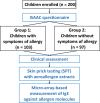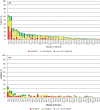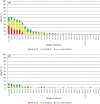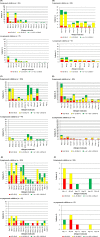IgE-reactivity profiles to allergen molecules in Russian children with and without symptoms of allergy revealed by micro-array analysis
- PMID: 32869350
- PMCID: PMC7891667
- DOI: 10.1111/pai.13354
IgE-reactivity profiles to allergen molecules in Russian children with and without symptoms of allergy revealed by micro-array analysis
Abstract
Background: The analysis of longitudinal birth cohorts with micro-arrayed allergen molecules has provided interesting information about the evolution of IgE sensitization in children. However, so far no cross-sectional study has been performed comparing IgE sensitization profiles in children with and without symptoms of allergy. Furthermore, no data are available regarding molecular IgE sensitization profiles in children from Russia.
Methods: We recruited two groups of age- and gender-matched children, one (Group 1: n = 103; 12.24 ± 2.23 years; male/female: 58/45) with symptoms and a second (Group 2: n = 97; 12.78 ± 2.23 years; male/female: 53/44), without symptoms of allergy according to international ISAAC questionnaire. Children were further studied regarding symptoms of allergy (rhinitis, asthma, atopic dermatitis) according to international guidelines, and skin prick testing with a panel of aeroallergen extracts was performed before sera were analyzed in an investigator-blinded manner for IgE specific to more than 160 micro-arrayed allergen molecules using ImmunoCAP ISAC technology.
Results: IgE sensitization = or >0.3 ISU to at least one of the micro-arrayed allergen molecules was found in 100% of the symptomatic children and in 36% of the asymptomatic children. Symptomatic and asymptomatic children showed a comparable IgE sensitization profile; however, frequencies of IgE sensitization and IgE levels to the individual allergen molecules were higher in the symptomatic children. Aeroallergen sensitization was dominated by sensitization to major birch pollen allergen, Bet v 1, and major cat allergen, Fel d 1. Food allergen sensitization was due to cross-sensitization to PR10 pollen and food allergens whereas genuine peanut sensitization was absent.
Conclusion: This is the first study analyzing molecular IgE sensitization profiles to more than 160 allergen molecules in children with and without symptoms of allergy. It detects similar molecular IgE sensitization profiles in symptomatic and asymptomatic children and identifies Bet v 1 and Fel d 1 as the predominant respiratory allergen molecules and PR10 proteins as the major food allergens and absence of genuine peanut allergy in Moscow region (Russia).
Keywords: Bet v 1; Fel d 1; PR10 protein; allergen; allergy; component-resolved diagnosis; food allergen molecules; food sensitization; micro-array; respiratory allergen molecules.
© 2020 The Authors. Pediatric Allergy and Immunology published by John Wiley & Sons Ltd.
Conflict of interest statement
RV has received grants from the Austrian Science Fund (FWF), Viravaxx, Vienna, Austria, and HVD Life Sciences, Vienna, Austria, and is recipient of a Megagrant of the Government of the Russian Federation, grant number 14.W03.31.0024. He serves as a consultant for Viravaxx, Vienna, Austria. Christian Lupinek has received honoraria from Thermo Fisher for lectures. All other authors declare that they have no relevant conflict of interest.
Figures




References
Publication types
MeSH terms
Substances
Grants and funding
LinkOut - more resources
Full Text Sources
Medical
Miscellaneous

